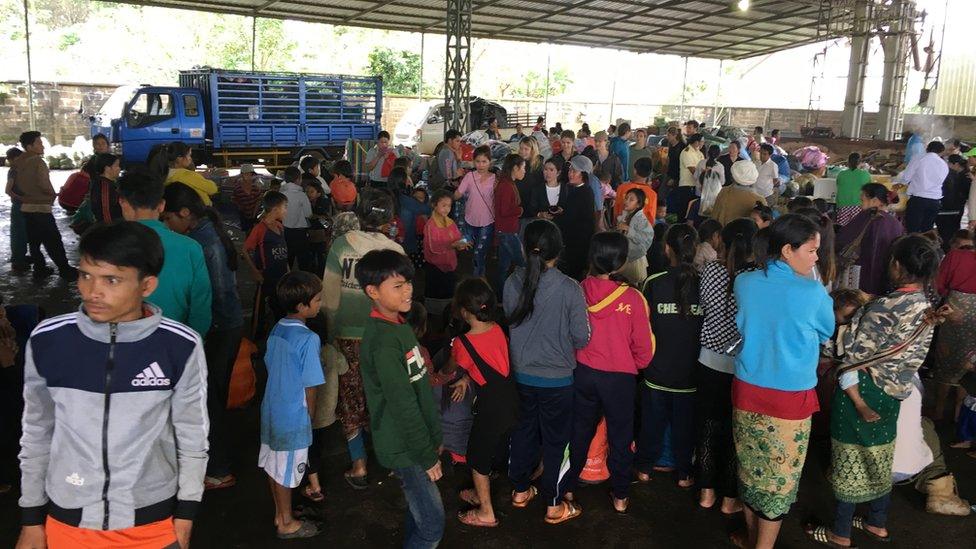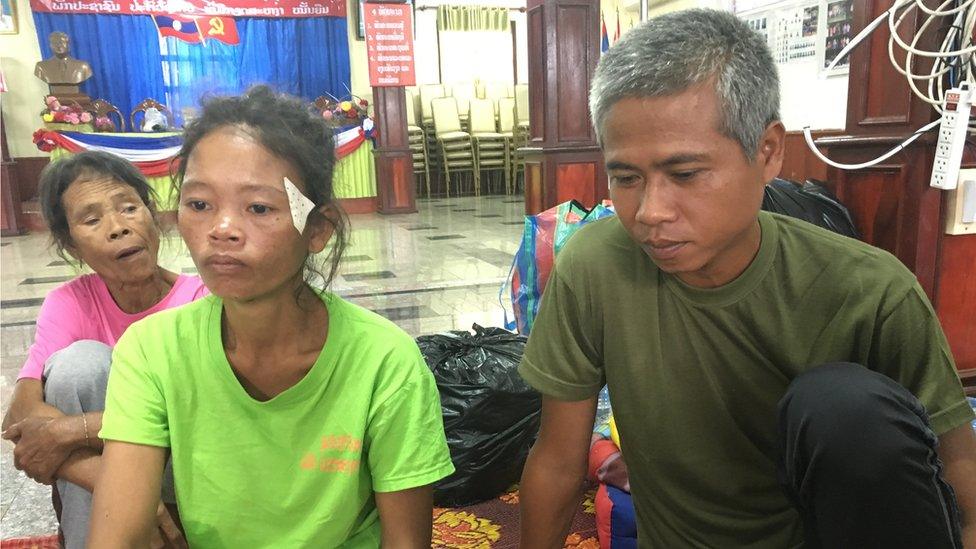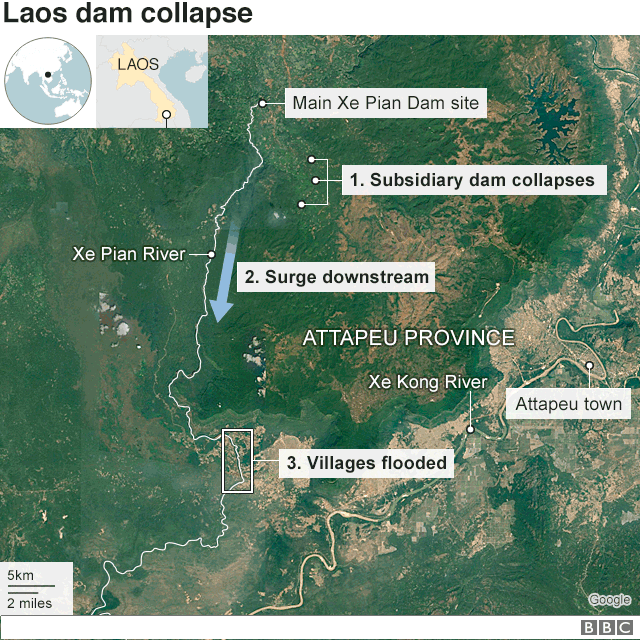Laos dam collapse: Survivors and NGOs query official toll
- Published

Conditions were basic at this emergency shelter in Paksong
The death toll from the dam collapse in Laos could be much higher than the official figure of 27, local people and aid agencies have told the BBC.
Few details of the rescue operation are being released by the Laotian authorities - but a BBC team managed to gain brief access to the site and survivors, despite a ban on foreign media.
At the main hospital in Attapeau, the town closest to the disaster zone, those who were injured and rescued have been receiving treatment.
They include La and his wife Aun, whose two daughters were swept away. La described how the current pulled the boat carrying his one-year-old daughter out of his hands.
"I put my daughter and my wife on the boat. I tried to hold it but the water was very strong. I couldn't hold it any longer and the boat flipped over and my daughter fell into the water," he said.

La and Aun told the BBC how their two daughters were swept away
As he and his wife desperately tried to find the toddler, their eldest girl aged four was also dragged under by the surging current.
"We tried to look for her but we could not find her. It all happened right before my eyes. I'm really shocked. I don't know who to blame - I just miss my children," he said.
A blow to the 'battery of Asia'
On Monday an auxiliary dam that was part of the Xe-Pian Xe-Namnoy hydroelectric power project collapsed. Fractures had been discovered on Sunday, a South Korean firm involved in its construction said.
Villagers seek refuge on roofs of submerged homes in Laos
Now a huge rescue operation is under way - but few details are being released by Laos's communist government.
That's partly because the authorities are habitually prone to secrecy and partly because of the remoteness of the affected region, which is hampering rescuers.
But the collapse is also a huge embarrassment for the Laos government, which has trumpeted its hydropower ambitions and desire to become the "battery" of South East Asia, selling energy to neighbouring countries.
It is now facing questions about how a brand new dam could collapse, sending water surging through paddy fields and villages, and how much warning nearby residents were given.
Official toll questioned
Government statistics say 27 people have been killed and 131 people are missing - but aid agencies believe the country may be downplaying the scale of the disaster and the final death toll may be considerably higher.
Local residents told the BBC that they believed as many as 300 people may have lost their lives.
Meanwhile up to 3,000 people are reportedly still stranded, their rooftops now islands in the murky floodwater.

The floodwater surged into seven villages, affecting two in particular. In an area of 200 houses, only about 10 were left standing, a Laotian medical official told Reuters news agency.
"We retrieved one body today. I suspect there will be more as the water goes down and the road becomes easier to access," the official said.
The official said villagers had been warned between three and four hours before the dam burst, but few thought the water would rise as high as it did.
How advanced is the relief effort?
About three hours' drive from Attapeau is Paksong, where hundreds of survivors were huddling in a rudimentary shelter. Medicine and blankets were being distributed and rice and soup were being cooked.
But most of those who found themselves there had lost everything. One grandmother told the BBC how the torrent had simply washed her house away.
Laotian troops and civilians are working together on the relief effort, loading up boats with instant noodles and fresh water. Chinese medical teams have joined the effort and more support is arriving from Thailand.

Laotian troops have been trying to reach affected villages
But the UN's humanitarian agency said that roads and bridges had been damaged, and boats and helicopters were the only means of transport in the worst-affected areas.
Schools were being used as evacuation centres and about 1,300 families needed tents for shelter, it added.
Additionally, about 1,300 families have been moved to higher ground in an area of northern Cambodia that has also been affected by the flooding.
What do we know about the dam?
Construction of the $1.2bn Xe-Pian Xe-Namnoy power project - a network of two main dams and five subsidiary dams - involved Laotian, Thai and South Korean firms.
The dam was 90% complete and had been set to start operating commercially next year.

The country is planning many more dams in the years to come, with the help of foreign and private investment
South Korea's SK Engineering & Construction, the main partner running the project, has blamed the collapse on heavy rain during the Laos monsoon season.
A company official said the firm had ordered the evacuation of 12 villages as soon as the danger became clear.
The Laotian Minister of Energy and Mines, Khammany Inthirath, has said the project's developers would be liable for all compensation, the Vientiane Times newspaper reported.